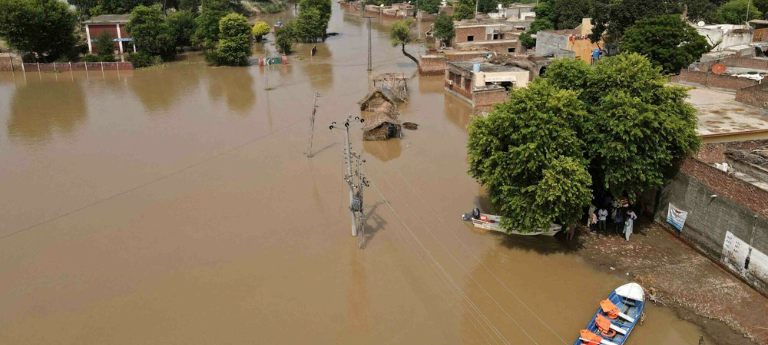Following rainfall in the upper catchment areas, the Sutlej River’s water level may increase even further during the course of the following 24 hours, the Punjab Provincial Disaster Management Authority and the Pakistan Meteorological Department warned on Wednesday.
Meanwhile, official data showed rescue teams have evacuated 81,136 people and transported 148,284 to safe locations from July 9 to Aug 23 in the 22 flood-hit districts of the province.
Besides, 16 people lost their lives and 36 were injured due to high flood in riverine areas, Rescue 1122 said.
The Sutlej river at the Sulemanki headworks had a high-level flood, according to the PDMA, with water flowing at a rate of 152,000 cubic feet per second (cusecs).
At 84,826 cusecs, the flow rate at Islam Headworks is lower, but it is rising quickly, and the PDMA has warned the local government and anticipated a high-level flood at the site within the next 24 hours. 28.3 litres are about equal to one cubic foot.
At the Ganda Singh Wala location, however, the water level has begun to recede as a water flow of 118,000 cusecs is passing through the spillway.
Flood levels at other rivers in Punjab were “normal”, the PDMA said, but warned that there was a risk of a high-level flood at Mangla in Jhelum river over the next three days.
The PMD also forecasted a medium to high-level flood from today and tomorrow (Aug 24 and 25) at Mangla. It warned that the water flow in Sutlej river might rise again if India released more water.
Over the upper catchments of all major rivers, “scattered to widespread wind-thunderstorm/rain of moderate intensity with isolated heavy falls” was predicted.
Imran Qureshi, the director general of the PDMA, claimed that the high flood had a negative impact on the catchment areas of Kasur, Okara, Pakpattan, Vehari, Bahawalnagar, Multan, Lodhran, and Bahawalpur.
He claimed that the government apparatus in the affected districts was on high alert and assisting flood victims.
Mr Qureshi visited Okara’s flood-affected areas, assessed the ongoing relief operations, and engaged with administrative officials.
He said that 769 officials had been deployed in several affected districts during the past 24 hours, including Bahawalnagar, Kasur, Okara, Pakpattan, Vehari, Multan and Lodhran.
He said 113 villages had been affected by floods during the past 24 hours, with medical facilities provided to more than 2,000 people and 44 relief camps set up.
Around 1,200 people received emergency transportation, and 2,616 people who were trapped in floods were evacuated immediately, according to him.
Additionally, while more than 85,000 acres of land have been impacted by the floods, 1,500 people received cooked food.
According to Punjab Relief Commissioner Nabil Javed, flood relief facilities and plans have been set up in the affected districts, and residents are being moved to secure areas.
At Talwar Post on the Sutlej River, according to Lahore Commissioner Muhammad Ali Randhawa, the water flow is currently 118,000 cusecs.
He directed Kasur Deputy Commissioner Arshad Bhatti to visit the flood relief camps of Kothi Fateh Muhammad, Attar Singh Wala, Baqir Kay, Tatara Kamil and Talwar Post.
Mr Randhawa said 40,913 people and 26,600 cattle heads had been moved to safe places from flood-hit areas.
In the third round of relief efforts, he said that 26,000 people had received food, 912 had received medical attention at the Kothi Fateh Muhammad medical camp, and 8,490 animals had received treatment.
In total, 7,531 individuals had received medical care and medications from 11 different medical campuses, while 1,100 individuals had received care from mobile hospitals, he claimed.
He said that eight police stations had been set up to protect the 15 evacuated communities and that Section 144 of the emergency code, which forbids assemblies in public spaces, had been implemented.
SOURCE: DAWN NEWS








